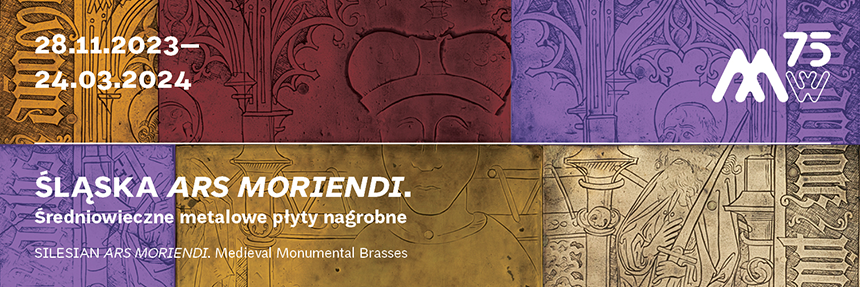„HI CONCULCARI QUAERUNT UT IN ASTRA LEVARI POSSINT ET PARITER VERIT”
They wanted to be trod upon so that they could reach the stars – inscription on the twelfth-century tomb slab from the church at Wiślica
Tomb slabs first appeared in Silesia probably in the thirteenth century and developed over the following centuries. The earliest monumental brasses (slabs featuring brass appliques) were likely the now-lost monuments of Bishops of Wrocław: Jan III Romka (d. 1301) and Henryk of Wierzbno (d. 1319). The earliest monumental brasses still extant are those of Duke Boleslaus I the Tall (d. 1201; actually, it was the second one made for him) and Duke Konrad of Żagań (d. 1304), both located in the monastic Church of the Assumption of the Blessed Virgin Mary in Lubiąż.
The characteristic features of monumental brasses reflected multiple traditions and rules. The place of burial was of particular importance as it depended upon the deceased parson’s social status. In the Early Middle Ages, by law only clergymen could be buries inside a church. Only exceptionally were lay persons honoured in this way. While in principle this law continued, from the twelfth century, church burials became more common: bishops were buried in their cathedrals and members of aristocracy and nobility in churches located in their hereditary estates and/or churches they or their ancestors founded.
Funerary slabs were mounted flush with the church’s floor to be trod upon in order to emphasize the deceased person’s Christian humility and the transient nature of temporal life. The monument’s placement within the church was likewise meaningful, with the chancel (presbytery) considered the most prestigious, followed by the site directly under the rood beam and chapels. Holy relics or a martyr’s grave enshrined in a church also enhanced its appeal as a burial place.
The monumental brasses depicted the deceased as living, with their eyes open: this manner of representation should be interpreted as the resurrected person presenting themselves to God and awaiting judgement deciding their fate for eternity. The image’s specific elements: the figure’s attitude, gestures, dress and attributes, coats-of-arms and inscriptions, identified the individual and at the same time commemorated them and testified to their earthly existence. The monuments’ iconography, sometimes straightforward and repetitive, on occasions quite complex and sophisticated, was often decided when the patron was still alive. Thus, it allows us an intimate peek into the medieval “art of dying”, illuminating how people in the Middle Ages dealt with the closeness and inevitability of death.
